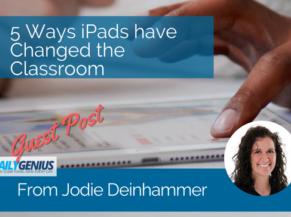This guest post from Jodie Deinhammer, Innovation Summit featured speaker, first appeared on Daily Genius.
When a cart of iPads was first delivered to my classroom, my first thought was, "Awesome, now we can Google stuff!" Fast forward 7 years and my students are now publishing iTunes U courses, authoring multi-touch books, and last year we collaborated with the Dallas Zoo to create educational resources to help protect endangered species.
What have I learned in the last 7 years?
My job has changed.
I no longer need to create presentations to deliver content. With a blended approach to the classroom, I can provide multiple resources for my students to learn class objectives. I can create a post in our iTunes U course that includes videos, multi-touch books, and web links from which to learn. Students can decide how they learn best and use the resource of their choice.
Assessment has also changed.
With so many ways to formatively assess my students, there is no longer a need to give a multiple choice end-of-unit test. I can use platforms and apps such as Quizizz, Kahoot, TodaysMeet and Quizlet to quickly assess the learning in my classroom. I can then easily gather data and use it to guide where we go next as a class.
Our classroom can be anywhere.
iPad allows us to easily take our classroom out of the building. We can go outside and take pictures of our environment and contribute to citizen science through the iNaturalist App. We can visit the local pond and do water testing using Pasco probes and the SparkVue App. We can visit the local farmers market and create a promotional video using iMovie or Spark Video to encourage others to buy local.
Students can choose how they share their learning.
When I want to know what my students know, I ask them to create something. I don’t specify an app or type of assignment, just create something to show me what you know. No longer do all assignments look the same. One student used Sketchbook to create original drawings of the cell to illustrate our multi-touch book while another group built a plant cell using Minecraft and videoed a voice-over tour to teach others the parts of the cell. Taking away guidelines and restrictions allows students to think creatively.
We learn from experts around the world.
With FaceTime and Skype, we can connect to experts around the world. When learning about endangered elephants, we connected with students in Thailand to learn more. We met Princess the Penguin in South Africa and talked to a rehabilitation specialist about adaptations of seabirds. This year we talked to students in Iceland about their environment. Connecting with schools outside of our community gives students a different perspective on the world and shows them that kids all over the world really are just like them.
This year, my students are collaborating with schools across the world to tackle the U.N.’s Sustainable Development Goals. Students are working together with others in Maine, California, Virginia, South Carolina, New Zealand, and Turkey to develop a plan that will make a difference in their community. Our students all access the same information in our iTunes U course, Global Problem Solvers, co-authored by Mia Morrison. They are using apps such as FlipGrid to globally collaborate and peer review each other as they ideate their plan. Once the plan is developed, students will use iMovie to film a short documentary to promote their cause. Classes will vote on the top ideas to move on to the implementation phase beginning in January.
While we still “Google stuff,” iPad has completely transformed our classroom from a teacher centered environment to a student designed and student-led classroom that is globally connected and making a positive impact on the world.

